|
Page updated
27-Dec-2010
|
In 1928 speedway spread through Britain like wildfire. The first meeting in this country had been at High Beech in February and by the end of the year fifty venues had opened. Naturally, a great many riders and promoters jumped on the bandwagon, but as winter approached they were wondering how to make a living before the 1929 season started. Wolf Barnato, a major shareholder in Bentley and an enthusiastic racer of the marque as one of the famous "Bentley Boys", was also a Director of the Egyptian Greyhound Racing Association. Some of the riders involved him in a scheme to gather together a team of nearly twenty riders and construct a track at the EGRA site at Zamalek, a district of Cairo on an island in the Nile River. The plan was that fifty percent of the gate would be distributed equally among the riders, in addition to the usual prize money. The rest of the team left on the SS California out of Liverpool on the 24th October, including Les Blakebrough, Colin Ford, Clem Cort, Tommy Croombs, Allan Kilfoyle, Del Forster, Jim Hayes, Les Barker, Harold Robinson, Wink Rece, Dudley Froy and Jack Adams. Ron Hewitt was in general charge of the party. Many boxes of spares were taken and Blakebrough had enough to build three complete new machines. He was regarded as the chief humorist of the party. The Egyptians were initially mystified by broadsiding and rolling starts. Their greatest source of amusement was a crash or a fall. After three race meetings on the track, the surface was practically unrideable, owing to the foundations sinking in places, and so another layer of stones had to be added to the foundations. Meetings were held on Friday evening, and Saturday and Sunday afternoons. Because of the dog racing connection, betting was permitted to the excitable Arab spectators, though it has always been forbidden in England. Ivor Creek finishes the story: "The wily locals soon rumbled that the racing was being rigged and that the betting wasn't entirely in their favour. Thus, the riders returned to England after only one short season, minus the fortunes they had anticipated." And so ended their arabian adventure - and speedway in the desert, until the British Army had a go during WWII.
|
